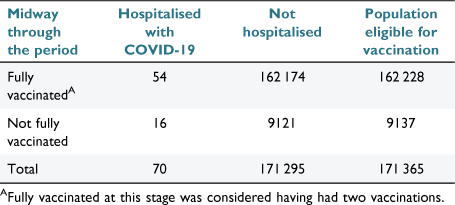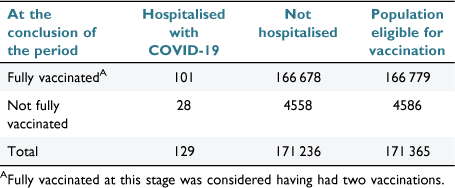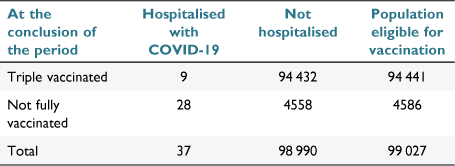Did the coronavirus vaccination program in a rural and regional area work? Health outcomes of the vaccination program in Wide Bay
Scott Kitchener A B *A Australian Centre for Health Law Research, Queensland University of Technology, George Street, Brisbane, Qld 4000, Australia.
B Wide Bay Hospital and Health Service, Nissen Street,. Uraween, Qld 4655, Australia.
Australian Health Review 47(1) 119-123 https://doi.org/10.1071/AH22144
Submitted: 13 June 2022 Accepted: 20 December 2022 Published: 19 January 2022
© 2023 The Author(s) (or their employer(s)). Published by CSIRO Publishing on behalf of AHHA. This is an open access article distributed under the Creative Commons Attribution 4.0 International License (CC BY).
Abstract
The objective of this case study is to evaluate the effectiveness of the Wide Bay region coronavirus vaccination program in preventing hospitalisation for coronavirus disease 2019 (COVID-19). Population vaccination data and the vaccination status of patients hospitalised with confirmed COVID-19 have been used to evaluate preventable hospitalisations and risk reduction during and after a 2 month period following the outbreak of COVID-19 in Wide Bay after removal of public health measures in Queensland in December 2021. Wide Bay is a rural region of Queensland including K’Gari (formerly Fraser Island) to the east, the North Burnett farming region in the west and extending from the Fraser Coast to the Discovery Coast. Two local regional hospitals received and managed hospitalised COVID-19 patients. The region had, at this time, 171 365 people 20 years and older eligible for coronavirus vaccination. The risk reduction for hospitalisation of those receiving fewer than two vaccinations, two vaccinations and three vaccinations was calculated to determine the vaccination program effectiveness. The program achieved 90% effectiveness for people with two or more vaccinations (those with two vaccinations and those receiving boosters of third or more vaccination), and 97% effectiveness for those having received three vaccinations, in preventing hospitalisation for COVID-19 during the period. This translated into a significant risk reduction for hospitalisation for those receiving two or more vaccinations, preserving capacity to enable the health service to manage all cases locally.
Keywords: coronavirus vaccination program effectiveness, COVID-19, preventable hospitalisation, regional health service.
Introduction
Queensland began a coronavirus disease 2019 (COVID-19) vaccination program in February 2021, having recorded only six deaths and 1386 cases in the state.1 Of these, 302 were determined to have been locally acquired cases, with most cases considered to have been introduced by international and interstate arrivals. Victoria had experienced a significant wave of COVID-19 from local transmission.2 Queensland Health responded with policies and plans for a vaccination service centrally commanded, conducted by regional hospital and health services, and informed by the Australian COVID-19 vaccination policy, which arises from the Australian COVID-19 vaccine and treatment strategy.3–5 The goals of the strategy intervention are not specified, however, based on the indications for available vaccines the goal is to prevent COVID-19 sufficiently severe to require hospitalisation. General practices, pharmacies and the health service joined into a vaccination program involving predominantly BNT162b2 (Pfizer BioNTech), but also ChAdOx1-S (Oxford AstraZeneca) and mRNA-1273 (Moderna) vaccines. These vaccines have demonstrated immunogenicity and have reduced moderate and severe disease incidence, however, the Australian public assessment reports on each do not include the impact on regional hospitalisation.6
In early December the Premier announced that once 80% of the eligible population in Queensland had been vaccinated twice, interstate border travel restrictions would be eased to permit fully vaccinated individuals to enter without needing to quarantine.7 At this time, fully vaccinated individuals had received two vaccinations. Requirements for entry eased on 13 December 2021.8 Public health and social measures restricting patrons to businesses, activities and other undertakings in Queensland were also to be lifted for vaccinated patrons.9,10
On the day of opening of Queensland borders, only 10 new cases of COVID-19 were notified in Queensland. One week later, 59 cases were notified, and 784 cases 1 week after that. The vaccination program continued after achieving vaccination of 80% of the eligible population, although it slowed as a result of Christmas and New Year holidays. In the new year, the capacity requirements of the program were expanded to include vaccination of children and initiation of delivery of a third dose of the vaccination schedule.
Objective
The objective of this evaluation is to determine the effectiveness of the vaccination program in Wide Bay in preventing hospitalisation due to COVID-19 upon the outbreak following the easing of public health measures.
Setting and participants
Wide Bay is a rural region of Queensland that extends from the traditional lands of the Butchulla, Gubbi Gubbi and Wakka Wakka people from K’Gari (formerly known as Fraser Island) in the east to the upper reaches of the Burnett River in the west, and north to the towns of 1770 and Monto. The region has two main population centres: the Fraser Coast with a population estimated at 109 856 in 2021, and Bundaberg with 96 914 people in 2021.11,12 These regional centres are serviced by three public hospitals providing specialist services. There are eight rural communities in the North Burnett and Isis regions serviced by public rural hospitals of the Wide Bay Hospital and Health Service. Bundaberg and Hervey Bay Hospitals developed dedicated COVID-19 wards and intensive care capability upon becoming eligible for admitting COVID-19 cases from 18 December 2021.13
The coronavirus vaccination program in Wide Bay was conducted by general practices, pharmacies and a private respiratory clinic, supplied with vaccines by the Commonwealth government. Additionally, a community and hospital-based program has been conducted by the Queensland Hospital and Health Service. The Hospital and Health Service contribution included semi-permanent vaccination centres at TAFE campuses in Bundaberg and Hervey Bay and in the City Hall at Maryborough, at the seven Health Service rural hospitals augmented with staff for pop-up clinics at locations around the region including the smaller communities, and a specialist referral clinic to support complex, high risk and other difficult vaccination cases. Commonwealth provisional registration of the vaccines and guidelines for use were common to these efforts, but governance of and coordination of providers were separate.
Methods
This operational evaluation utilised collated routinely reported data from the Hospital and Health Service and from the Queensland Health Service Research, Analysis and Monitoring Unit. The evaluation and report were approved for preparation and release for peer review by the responsible data custodians.
The vaccination status of people aged 20 years or older who were confirmed to have COVID-1914 and who were admitted to Wide Bay Hospital and Health Service facilities, was provided for the 2 month period after the revocation of the Chief Health Officer Directive regarding quarantine for arrivals to Queensland and the presentation of the first case of COVID-19 on 18 December 2021. This age range was determined by the available population data regarding vaccination. Available data were collated and summarised by 10 year age groups. Younger vaccinated residents were not included in this analysis because vaccination of children had only recently begun at this time.
The population vaccination status was assayed mid-period (18 January 2022) and at the conclusion of the 2 month observation period (18 February 2022). Risk of hospitalisation with COVID-19 has been calculated for three groups: first, those with fewer than two vaccinations, who are considered unvaccinated; second, those with two vaccinations, who were considered fully vaccinated at the beginning of the period of sampling; and last, those with three vaccinations by the end of the sampling period, given that the third vaccination became available mid-sampling period to redefine ‘fully vaccinated’.
Vaccination program effectiveness in the region has been calculated using the reduction in risk of hospitalisation in vaccinated people of the region compared with unvaccinated persons. Averted hospitalisation has been calculated based on observed and expected projected hospitalisations had there been no vaccination. Odds ratios and confidence intervals have been calculated using conventional methods.15
Outcomes
A total of 140 patients aged 20 years or older were admitted with COVID-19. Of these, 129 patients had confirmed vaccination records available. All patients were managed within the resources of this regional health service. No patients were transferred out of the region. Those patients identified in rural hospitals (the service includes eight rural facilities in Australian Statistical Geography Standard – Remoteness Area (Modified Monash Model) 4 and 5 communities) were transferred to one of two general hospitals (Bundaberg and Hervey Bay Hospitals) for inpatient care.
Midway through this period 162 228 residents of Wide Bay had received two or more doses of coronavirus vaccine (94.67%), and 9137 people aged 20 years or older had not (Table 1). At the close of the period 166 779 people had received two or more doses, of whom 94 441 had received three doses, leaving 4586 who had received one vaccination or had not been vaccinated (Tables 2, 3).

|

|

|
The risk of COVID-19 requiring hospitalisation by the end of the period for those remaining unvaccinated (4586) was 3.05/1000 per month. For those with two or more vaccinations the risk reduced to 0.30/1000 per month and for those who had received three doses of vaccine by the conclusion of the period (94 441) the risk of hospitalisation with COVID-19 was 0.095/1000 per month.
The odds ratio of admission to hospital if not vaccinated in this 2 month period was 10.1 (95% CI: 6.66–15.4, P < 0.0001) compared with those with two or more vaccinations by the end of the period. During this period, the delay before third vaccine dosing was shortened to 3 months after the second dose. On comparison of those people not vaccinated (one or no vaccinations) with those vaccinated with three doses at the end of the period, the odds ratio was 32 (95% CI: 17.7–57.8, P < 0.0001).
Risk reduction for hospitalisation with COVID-19 for those with two or more vaccinations indicates a vaccine effectiveness of 90%. The effectiveness of three vaccine doses by the end of the period was 97%.
Using the median time population vaccination status, 396 hospitalisations are predicted to have been averted. Using the end period population vaccination status, this rises to 917 hospitalisations having been averted during the period. These are artificial predictions, given that at lower vaccination levels the transmission would rise in a non-linear fashion, suggesting that the number of actual hospitalisations would be greater had there been lower levels of vaccination.
Discussion
This evaluation does not discern the independent effectiveness of each contribution to the vaccination program throughout the region, but rather the collective health outcome of hospitalisations as a measure of regional COVID-19 vaccination effectiveness. Cases of COVID-19 in this region have not, during this observation period, ‘leaked’ to other locations in terms of transfers to other or more capable hospitals for care. It is conceivable that some of the vaccinations delivered have been for people who were visiting the region for holidays or itinerant work.
The relaxation of quarantine requirements for interstate travellers and public health and social measures in mid-December reflected a shift to a dependence on the vaccination status of travellers and the community to manage the impact of COVID-19. In the following week community transmission began in the region. From this time, COVID-19 cases presenting for hospitalisation were able to be retained in the region in either Bundaberg or Hervey Bay Hospitals. As a broad assessment of effectiveness, this vaccination program has mitigated the health impact of this wave of COVID-19 so that it is manageable locally in this region. This is a significant outcome for a regional health service to not require out-of-region health support, and a major benefit for locally resident patients presenting with COVID-19.
Vaccination rates at the midpoint and conclusion of the sampling period overestimate the effective immunised rate of the population and create a bias towards the null for vaccination program effectiveness given that newly vaccinated people are less protected in the days following their vaccination. Projecting cases using the rate of COVID-19 in unvaccinated residents to the total population also biases towards the null given that transmission would be expected to be disproportionally higher with more than 5% of the population unvaccinated. The relationship is unlikely to be linear. Therefore, hospitalisation averted should be interpreted with caution as an indicator of effectiveness in preventable hospitalisations. These findings, however, although conservative, are significant for health service management during an outbreak.
The vaccination program effectiveness determined here is greater than real-world study findings, which range from 43% to 86% effectiveness in preventing hospitalisation for COVID-19.16 These studies do utilise different methods of assessment; all are sampling prior to Omicron as the predominant severe acute respiratory syndrome coronavirus 2 (SARS-CoV-2) variant and are less able to capture all hospitalisations than was possible in this evaluation. They also do not assess regional health service capacity or capability for local patient care.
In Wide Bay, during this period, absolute risk reduction for hospitalisation for individuals was quite modest (1.42/1000 per month for double vaccinated and 2.96/1000 per month for triple vaccinated individuals). However, despite this modest individual benefit, the overwhelming majority of people of the region were vaccinated and a significant impact has been experienced in reducing hospitalisations associated with the vaccination effort in this region.
Lessons
As for many public health measures and particularly vaccination, the individual benefit is limited; however, the health service and population benefits are significant and compounding. Mitigation of presentation to hospital preserved inpatient capacity. This in turn maintained greater available capacity for other care. Mitigation of the load of admitted COVID-19 cases also preserves hospital capability, particularly in medical and intensive care services. Having managed the vaccination program locally, the region accommodated the clinical load of presenting COVID-19 cases without recourse to resources outside of this region. Preserved capacity and capability and reduced extra-regional transfers are all desirable local health service outcomes from the vaccination program. Continued maintenance of high vaccination rates for the prevention of COVID-19 is recommended to maintain manageable levels of hospitalisation for COVID-19 in the region to support the local health care service. This need will vary as the SARS-CoV2 becomes endemic and with variants necessitating relevant vaccines to be incorporated into the program. Threats to this health service enabler are concentration of vaccine program responsibility to other providers with limited capacity for further service expansion, such as general practice in this region. The health service should maintain capability for complex and higher risk vaccinations in these circumstances.
Data availability
Source data are available from the Hospital and Health Service and from the Queensland Health Service Research, Analysis and Monitoring Unit.
Conflicts of interest
The author is a full-time employee of the hospital and health service that is the subject of this evaluation.
Declaration of funding
This research did not receive any specific funding.
References
[1] Stevenson A. COVID-19 vaccine rollout begins in Queensland, as nurses, policy inspector receive first jabs on the Gold Coast. ABC News, 22 February 2021. Available at https://www.abc.net.au/news/2021-02-22/coronavirus-vaccine-rollout-queensland-gold-coast/13177542 [cited 14 April 2022].[2] COVID-19 Australia: Epidemiology Report 35: Reporting period ending 14 February 2021. Comm Dis Intell 2021; 45 1–10.
| COVID-19 Australia: Epidemiology Report 35: Reporting period ending 14 February 2021.Crossref | GoogleScholarGoogle Scholar |
[3] Queensland Health. COVID-19 vaccination services policies and plans. Available at https://www.health.qld.gov.au/system-governance/strategic-direction/improving-service/covid-19-policies-and-plans/vaccination-services [cited 14 April 2022].
[4] Department of Health and Aged Care. Australia’s COVID-19 vaccine and treatment strategy. 18 August 2020. Available at https://www.health.gov.au/resources/publications/australias-covid-19-vaccine-and-treatment-strategy [cited 14 April 2022].
[5] Department of Health and Aged Care. Australian COVID-19 vaccination policy. 13 November 2020. Available at https://www.health.gov.au/resources/publications/covid-19-vaccination-australian-covid-19-vaccination-policy [cited 14 April 2022].
[6] Therapeutic Goods Administration. COVID-19 vaccine: provisional registrations. Available at COVID-19 vaccine: Provisional registrations | Therapeutic Goods Administration (TGA) [cited 2 June 2022].
[7] Queensland Government. Queensland borders re-open. Joint Statement of the Premier of Queensland and Minister for the Olympics and the Minister for Health and Ambulance Services, 6 December 2021. Available at https://statements.qld.gov.au/statements/93994
[8] Queensland Health. Border Restrictions Direction (No. 56), 9 December 2021. Available at https://www.health.qld.gov.au/system-governance/legislation/cho-public-health-directions-under-expanded-public-health-act-powers/revoked/border-restrictions-56
[9] Queensland Health. Revoked - Restrictions on Businesses, Activities and Undertakings Direction (No. 29), 16 December 2021. Available at https://www.health.qld.gov.au/system-governance/legislation/cho-public-health-directions-under-expanded-public-health-act-powers/revoked/business-activity-undertaking-direction-29
[10] Queensland Health. Public Health and Social Measures Linked to Vaccination Status Direction, 7 December 2021. Available at https://www.health.qld.gov.au/system-governance/legislation/cho-public-health-directions-under-expanded-public-health-act-powers/revoked/public-health-and-social-measures-linked-to-vaccination-status-direction
[11] ID Community. Fraser Coast Regional Council community profile. Available at Estimated Resident Population (ERP) | Fraser Coast Regional Council | Community profile [cited 1 June 2022].
[12] ID Community. Bundaberg Regional Council community profile. Available at Estimated Resident Population (ERP) | Bundaberg Regional Council | Community profile [cited 1 June 2022].
[13] Queensland Health. Designated COVID-19 Hospital Network Direction (No. 5), 7 December 2021, revoked 18 December 2021. Available at https://www.health.qld.gov.au/system-governance/legislation/cho-public-health-directions-under-expanded-public-health-act-powers/revoked/revocation-of-designated-covid-19-hospital-network-direction-no.5
[14] Department of Health and Aged Care. Series of National Guidelines, COVID-19, version 6.4. Canberra: Department of Health and Aged Care; 2022.
[15] SciStat. Statistics anytime, anywhere. Odds ratio calculator. Available at scistat.com
[16] Henry DA, Jones MA, Stehlik P, Glasziou PP. Effectiveness of COVID-19 vaccines: findings from real world studies. Med J Aust 2021; 215 149–151.e1.
| Effectiveness of COVID-19 vaccines: findings from real world studies.Crossref | GoogleScholarGoogle Scholar |


